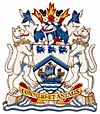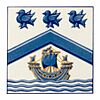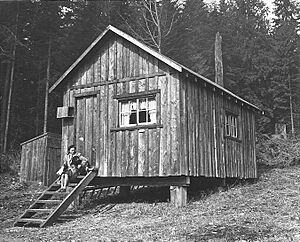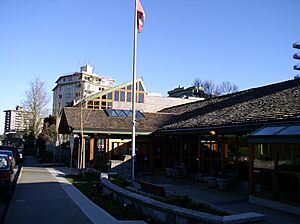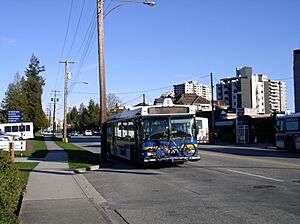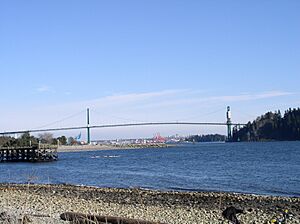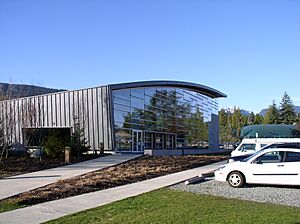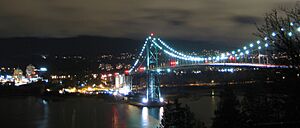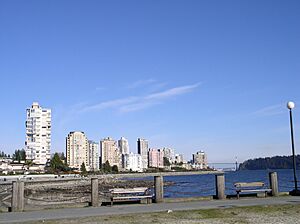West Vancouver facts for kids
Quick facts for kids
West Vancouver
|
|||||
|---|---|---|---|---|---|
|
District municipality
|
|||||
| The Corporation of the District of West Vancouver | |||||
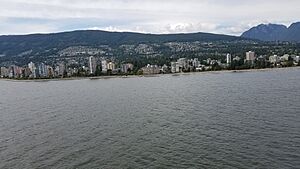 |
|||||
|
|||||
| Nickname(s):
West Van
|
|||||
| Motto(s):
"Consilio et animis" (English: "By wisdom and courage")
|
|||||
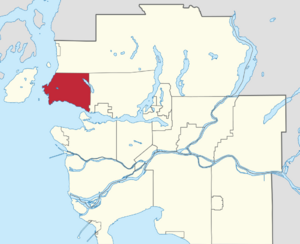
Location of West Vancouver in Metro Vancouver
|
|||||
| Country | Canada | ||||
| Province | British Columbia | ||||
| Regional district | Metro Vancouver | ||||
| Incorporated | March 15, 1912 | ||||
| Government | |||||
| • Type | Mayor-council government | ||||
| • Body | West Vancouver Council | ||||
| Area | |||||
| • Land | 87.18 km2 (33.66 sq mi) | ||||
| Highest elevation
(Mt Strachan)
|
1,440 m (4,720 ft) | ||||
| Lowest elevation | 0 m (0 ft) | ||||
| Population
(2021)
|
|||||
| • Total | 44,122 | ||||
| • Estimate
(2023)
|
46,358 | ||||
| • Density | 506.1/km2 (1,311/sq mi) | ||||
| Demonym(s) | West Vancouverite | ||||
| Time zone | UTC−08:00 (PST) | ||||
| • Summer (DST) | UTC−07:00 (PDT) | ||||
| Forward sortation area |
V7S–V7W
|
||||
| Area codes | 604, 778, 236, 672 | ||||
West Vancouver is a town in British Columbia, Canada. It is part of the Metro Vancouver Regional District. West Vancouver is located on the north side of Burrard Inlet, just northwest of the city of Vancouver. Along with the District of North Vancouver and the City of North Vancouver, it's part of a group called the North Shore municipalities. West Vancouver is known for being one of the wealthiest towns in Canada.
This town is home to the Horseshoe Bay ferry terminal. This is a major travel spot that connects the mainland of British Columbia to Vancouver Island. A big part of Cypress Provincial Park is also located here.
Contents
History of West Vancouver
The town of West Vancouver became its own municipality on March 15, 1912. Before this, it was part of the District of North Vancouver. The first local election was held on April 6, 1912.
A big change happened in November 1938 when the Lions Gate Bridge opened. Before the bridge, people could only reach West Vancouver by ferry. The bridge helped the community grow a lot. While some homes date back to the 1920s and 30s, most houses were built in the 1970s and 80s. Many of these newer homes are in areas developed by British Pacific Properties.
Important Dates in West Vancouver
- 1792: Captain George Vancouver names Point Atkinson.
- 1866: John Thomas, also known as "Navvy Jack," arrives. He is the first European resident of West Vancouver. He started the first ferry service to Vancouver using a rowboat. His old house is still standing today at Ambleside.
- 1872: James Blake claims the first 65 hectares (160 acres) of land.
- 1875: The first lighthouse is built at Point Atkinson.
- 1905: John Lawson, a local leader, settles at the foot of 17th Street.
- 1908: The first pier, Hollyburn Pier, is built.
- 1909:
- The West Vancouver Transportation Company starts ferry service across the harbor to Vancouver.
- A "real estate boom" happens, with land selling for $450 to $4,500.
- 1911: The first primary school opens at the Presbyterian Church in Dundarave.
- 1912:
- West Vancouver officially separates from the District Municipality of North Vancouver on March 15.
- The population is about 1,500 people.
- The first local election is held.
- John Teare is appointed as the first police constable on May 17.
- 1913: Hollyburn Elementary School is built, becoming the longest-existing school in West Vancouver.
- 1914: The Pacific Great Eastern Railway starts service from North Vancouver to Caulfeild and Horseshoe Bay.
- 1915:
- Dundarave Pier is built.
- Marine Drive officially opens.
- 1916: West Vancouver Municipal Transport starts bus service.
- 1922: British Columbia Electric Railway begins electrical service.
- 1926: Marine Drive is extended to Horseshoe Bay. A new law, the Town Planning Act, makes West Vancouver a residential-only community.
- 1928: Direct telephone service to Vancouver begins.
- 1932: 1,600 acres (650 hectares) of land are bought by A.R. Guinness-Br. Pacific Properties. This land becomes the British Properties.
- 1938: The Lions Gate Bridge is finished and opens on May 29. The Guinness family helped pay for the bridge.
- 1947: Ferry service stops because the bridge makes it unnecessary.
- 1950:
- The West Vancouver Memorial Library opens.
- Park Royal Shopping Centre, Canada's first shopping mall, opens.
- 1963: Tolls (fees) on the Lions Gate Bridge are removed on April 1.
- 1973: Clyde McRae finishes a world record walk across Canada at Ambleside Beach.
What to Do in West Vancouver
West Vancouver is mostly a place where people live. Many residents are retired or work from home. Others travel a short distance to downtown Vancouver for work.
A 13-block area of Marine Drive is the main shopping street. Here you can find shops, offices, restaurants, banks, and other useful services. The area between 13th and 19th Streets is called Ambleside Village. The area between 24th and 26th Streets is known as Dundarave.
West Vancouver is also home to Park Royal Shopping Centre, which was Canada's first mall. It opened in the 1950s and is now one of the largest malls in British Columbia. A big bus station for local buses is located near Park Royal.
The West Vancouver Memorial Library, located in Ambleside, is very popular. It has the highest number of books borrowed per person in Canada!
People and Population
In 2021, West Vancouver had a population of 44,122 people. This was a small increase from its 2016 population of 42,473. The town covers an area of about 87 square kilometers.
West Vancouver has a higher percentage of older people compared to the rest of British Columbia. About 22% of people are aged 65 or older. Many people in West Vancouver work in science, retail, healthcare, finance, and education. A large number of residents also hold senior management positions.
Different Backgrounds
West Vancouver is home to people from many different backgrounds. Here's a look at the main groups:
- European: The largest group, though their percentage has decreased over time.
- East Asian: This group has grown significantly in recent years.
- Middle Eastern: This group has also seen a rise in population.
- South Asian
- Southeast Asian
- Indigenous
- Latin American
- African
Languages Spoken
Most people in West Vancouver speak English at home. However, many other languages are also spoken.
- English is the mother tongue for about 67% of the population.
- Persian is the second most common mother tongue.
- Chinese languages, including Mandarin, are also widely spoken.
- Other languages include German, Korean, and French.
Wealth in West Vancouver
West Vancouver is known as Canada's wealthiest town. The average household here has a net worth of over $4.4 million. Many homes in West Vancouver are very large and expensive. In 2011, the average house sold for over $2 million. More than 80% of families in West Vancouver have a total income of at least $100,000 per year.
Getting Around West Vancouver
West Vancouver has its own bus system called West Vancouver Municipal Transit, often called Blue Bus. This bus company works with TransLink to provide public transportation. You can transfer between Blue Bus and other TransLink buses for free.
The main highway in West Vancouver is British Columbia Highway 1, which is part of the Trans-Canada Highway. It starts in Horseshoe Bay and goes east. British Columbia Highway 99 also runs through West Vancouver. It connects the town to Downtown Vancouver (using the Lions Gate Bridge) and Whistler.
You can also take a BC Ferries boat from Horseshoe Bay. Ferries go to Nanaimo on Vancouver Island, Bowen Island, and the Sunshine Coast.
Parks and Fun Things to Do
West Vancouver is famous for its beautiful parks. Cypress Provincial Park offers amazing views of Howe Sound and the Vancouver area. Whytecliff Park and Lighthouse Park, near Horseshoe Bay, are also popular. All of West Vancouver is built on the side of the Coast Mountains. This means many homes have great views of Vancouver Island, the Lower Mainland, or Howe Sound.
Ambleside Park and the 15-block-long West Vancouver Seawall are great places for families and people who love the outdoors. Whytecliff Park is considered one of the best places for scuba diving in Western Canada. The town also has many smaller parks. Lighthouse Park at Point Atkinson has some very old trees and offers views of Vancouver. John Lawson Park is another favorite spot for families. It has a playground, a grassy area for picnics, and a view of the Lions Gate Bridge and the downtown skyline.
West Vancouver has many public places for recreation. These include an 18-hole golf course, a swimming pool, an ice rink, basketball and tennis courts, and skate parks. The West Vancouver Community Centre was rebuilt and opened in 2009. Cypress Provincial Park also has mountain biking trails and a large ski and snowboard resort. This resort was even a venue for the 2010 Winter Olympics.
Schools and Learning
West Vancouver has 17 public schools, which are part of School District 45 West Vancouver. There are also 4 private schools in the town. Out of these 21 schools, 6 are high schools. More than 80 percent of high school graduates from West Vancouver go on to college or university. Many students from nearby Squamish, the Sunshine Coast, and North Vancouver also attend schools in West Vancouver.
Images for kids
-
West Vancouver (left side) as seen from Stanley Park.
See also
 In Spanish: West Vancouver para niños
In Spanish: West Vancouver para niños



